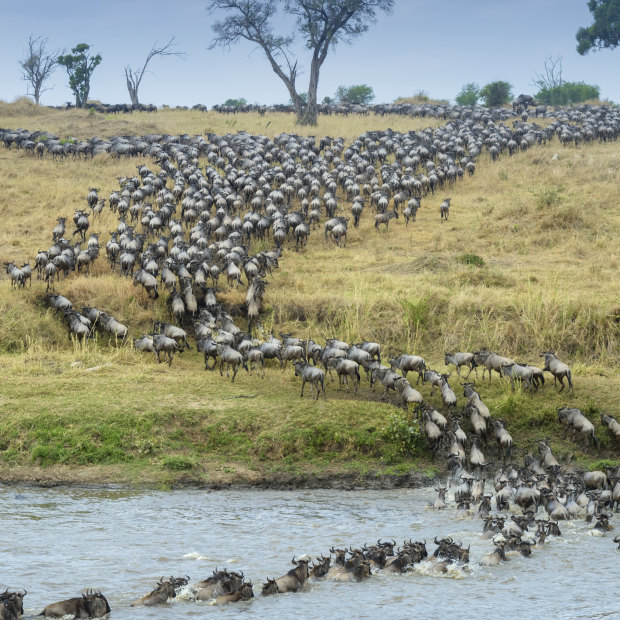
The Masai Mara, bordering onto Tanzania’s Serengeti National Park, is best known as the home of the great migration, where in July and August every year, more than 2 million wildebeest, zebra and other animals made the long trek between the countries, crossing raging rivers and being picked off by predators along the way.Credit: iStock
A golden lion, his magnificent mane rippling in the breeze, lounges atop a termite mound, roars – well, maybe it was a yawn – and then ambles over to a sleek lioness lying nearby.
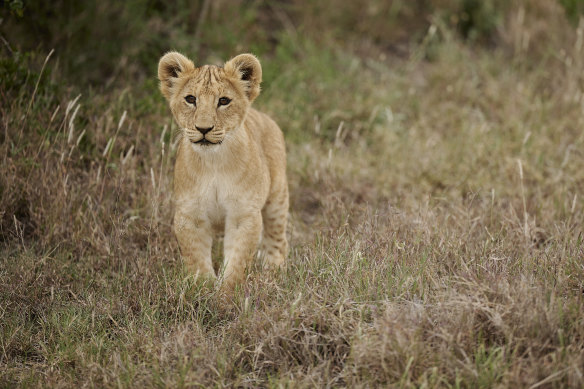
The real deal: a cub in the Ol Pejeta Conservancy.
He’s the proverbial king of all he surveys on this sunlit savannah, except, it appears, his mate. Drunk on power and that lovin’ feeling, he climbs onto her back, only to have her unceremoniously shrug him off and bat him away, leaving him to slink off into the long grass to hide his humiliation.
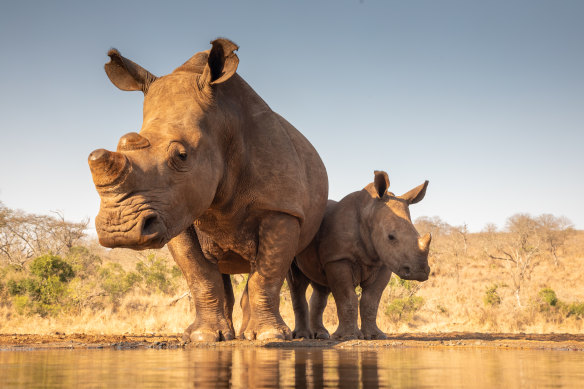
Endangered rhinos at a water hole.Credit: iStock
Someone in the safari truck starts humming Circle of Life, from The Lion King movie, and soon everyone has joined in. The joy of simply being in Africa, quite apart from the sight of those glorious lions, is infectious.
Speaking of royalty, 30 years have passed since the original Oscar-winning The Lion King became the highest-grossing animated film of all time. In that time, even with the $US200 million ($295 million) prequel Mufasa about to be released, gender politics have changed enormously.
But this live-action sight of lions in Kenya’s Masai Mara, which inspired the first movie all those years ago and is now the muse to the next, is always a thrill, whether they’re hunting, playing with their cubs, resting, grooming themselves or their mate, or having their advances spurned.
I’m on an 11-day Abercrombie & Kent safari, not only to view the kings of the jungle but also to encounter the world’s last two northern white rhinos.
As it turns out, it was the group’s founder, Geoffrey Kent, who took Jeffrey Katzenberg, then chair of Walt Disney Studios and now DreamWorks co-founder, on safari, during which he reportedly came up with the idea for the first The Lion King movie.
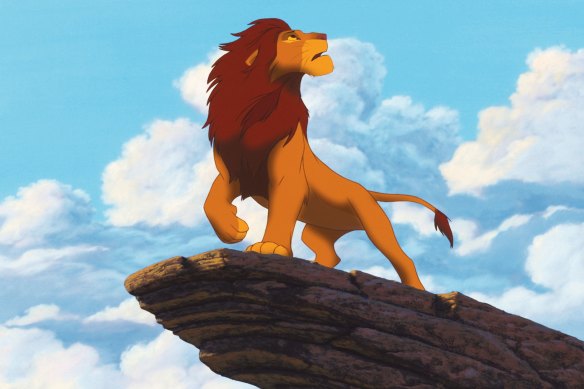
Enduring love… The Lion King’s upcoming sequel is attracting a lot of interest in Africa, 30 years after the original.Credit: Disney
The 1994 film tells the story of a lion cub, Simba, who is forced to leave the Pride Lands of Tanzania, which neighbours Kenya, after his father, Mufasa, is murdered by his wicked uncle, Scar. Years later, he returns as a young lion to reclaim his throne.
The prequel, Mufasa: The Lion King, now inspiring so much more enthusiasm for Africa, is due out on December 3, with the movie set to drive even more interest in this part of the world. In 2023, Kenya alone recorded an almost 32 per cent increase in visitors compared to 2022.
Meanwhile, veteran Abercrombie & Kent guide Peter Ojuku is meeting a growing number of Australians in Kenya every year, many of them visiting Africa for the first time.
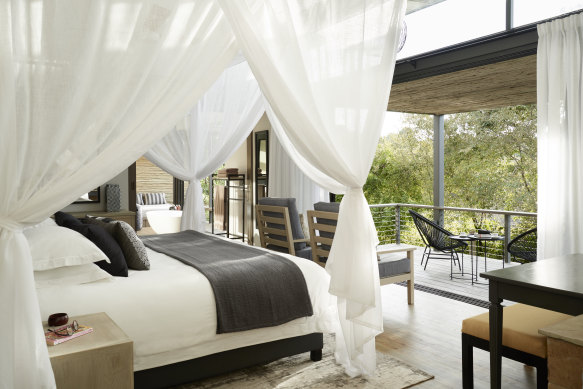
The Geoffrey Kent Suite at Sanctuary Olonana, Abercrombie & Kent’s first camp.
They’re often surprised by what they’re finding, too, not expecting the cities to be as modern, the conservancies to be so full of animals, the accommodation to be of such a high standard, and the food so good.
Warning: Zebra (and rhino) crossing ahead
As the vehicle bumps and grinds over the rich red earth and waving oat grasses of Ol Peteja Conservancy in Central Kenya, with the snow-capped peak of Mount Kenya glistening in the distance, the cry goes up: “Rhino!”
We pull off the rough track and head straight for a little family of black rhino – mum, dad and a baby that our guide, Ojuku, says looks about nine months old.
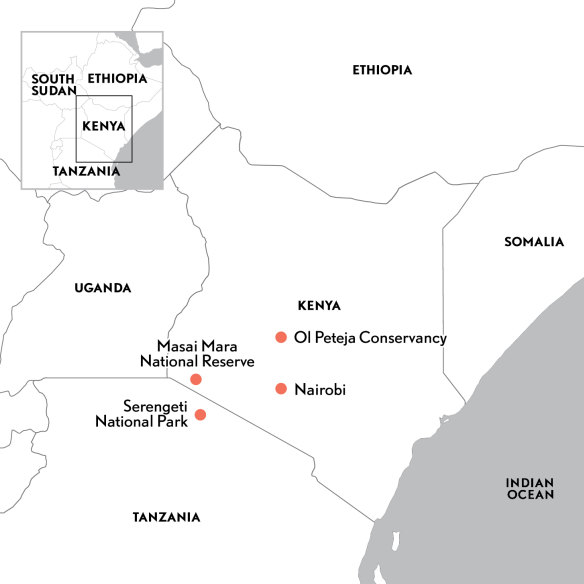
We pull up not far from them and sit and gaze as they graze, huge lumbering creatures keeping a wary eye on us until they’re reassured we’re not coming any closer.
It’s a precious sight and one of the reasons this 360-square-kilometre, not-for-profit wildlife sanctuary is so treasured. It’s the largest black rhino sanctuary in East Africa and sightings of rhinos, both black and southern whites – as well as the last two northern whites in existence – are common.
When, finally, we pull away, a crossing of zebras stands watching us, their black and white coats defying any attempt at camouflage against the knot of fever trees. Then they turn and move away, a tumble of stripes flashing before our eyes.
Just beyond them is a male impala, appearing hopelessly stressed as he watches over his 20-strong female harem of the prettiest antelope, busy looking after them and keeping them all to himself, away from other marauding rivals.
And the sights keep coming – kudu, Thomson’s Gazelle, hartebeest and then waterbuck, perhaps the luckiest animals on these sweeping plains. Although the white ring on their rumps is sometimes jokingly referred to as the “Follow Me” sign when running, they have a rare superpower. When in danger, they’re able to release a foul-smelling oil from their sweat glands, which tends to keep them far from the top of predators’ menus.
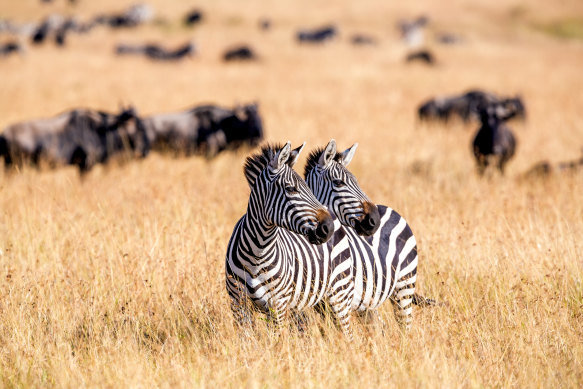
Zebra crossing.Credit: Getty Images
Kenya has experienced heavy rains this season which means the grasses are rich and green and keeping the country’s wildlife healthy, happy and fertile.
The evidence is everywhere, from the parade of elephants, with the young ones scurrying to keep up with their elders, to the herds of buffalo – otherwise known by the collective noun an “obstinacy”. They, tellingly, stand and glare at the baboons playing in the warm sun and warthogs darting around with their tails straight up to warn others of danger.
Predictably, that first warthog sighting inspires a cry of “Pumbaa!” another The Lion King favourite, and then another disorderly chorus, this time of Hakuna Matata.
Along another path, we suddenly come across a tower (as it’s known) of giraffes, almost 20 with long necks waving in a kind of forest of their own, and two young males fighting for supremacy in a battle all too common to every species.
Giraffes, however, scrap in a distinctive way, whacking each other with their necks to see who tires first and trying to stab with the small horn-like knobs on their heads.
Even the least popular creatures can look gorgeous in such a setting. At one point, we spot a clan of spotted hyenas in their shallow den and drive towards them.
A couple of the mothers who run the show come out to warn us off but can’t stop eight of the fluffy babies darting curiously towards us. It’s an absolute joy to watch them playing and tumbling over one another in a gorgeous show of high spirits.
Jackal pups, the small dogs with pointy ears, look similarly adorable – until two pounce on a tiny impala calf and tear it apart, as its mother cries, heartbreakingly, close by. A mad chirping of birds warns other animals that killers are in their midst.
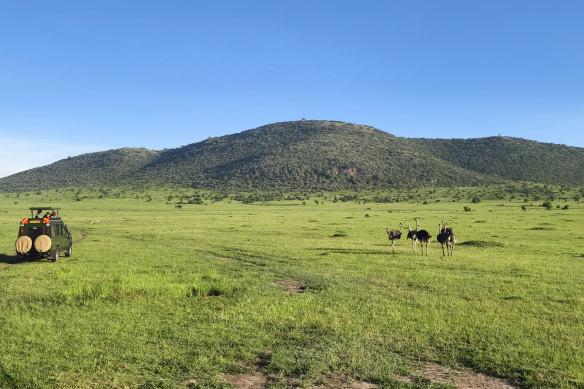
The famed Masai Mara.Credit: iStock
At our next stop, in the famed Masai Mara in southern Kenya, a 40-minute Twin Otter flight away, it’s only three minutes after landing that we spot our first lion, its mating attempts rebuffed. It’s the first of many, too, with others lounging, playing, rolling in the mud and grooming themselves.
The Masai Mara, bordering onto Tanzania’s Serengeti National Park, is best known as the home of the great migration, where in July and August every year, more than 2 million wildebeest, zebra and other animals made the long trek between the countries, crossing raging rivers and being picked off by predators along the way.
Quite apart from the lion stars, there are also leopards slinking through the tall grasses and cheetahs striding powerfully past. Although they can run at up to 120 km/h as the fastest animal on land, they’re often too meek to manage to keep their kill, even being scared away by hyenas, jackals and vultures.
All the creature comforts
At Ol Peteja, I stay in Abercrombie & Kent’s newest camp, Sanctuary Tambarare, an eco-friendly collection of 10 luxury tents and a private villa set in the deep bush.
The word “tent” is a stretch. While two of the walls are indeed canvas, the front has sliding glass doors onto a vast wooden deck, while the interior has high ceilings, a huge bed swathed in white mosquito netting, easy chairs and a full, luxurious ensuite.
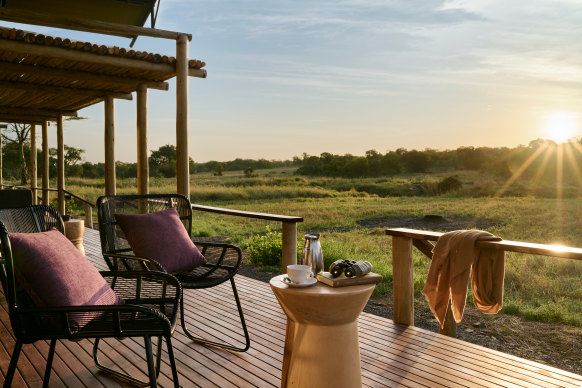
Sanctuary Tambarare suite.
At night and in the early mornings, you walk between the tent and the camp’s main lounge, with its chandeliers, sofas, and dining area facing a waterhole. There, beautiful three-course meals – all included in the package – are served, along with drinks and a bar, the waterhole for humans.
At the Masai Mara, my accommodation is the stunning Sanctuary Olonana, Abercrombie & Kent’s first camp, perched above the raging Mara River, but one now completely refurbished to become one of its most luxurious.
Each of the 14 suites is right on the river, so you can sit on your deck watching dozens of hippos sliding around the mud on its banks and the odd crocodile slinking around them.
Glass-sided and completely private, they have a massive sunken lounge area with panoramic views to the water, another huge bed, a daybed and a pair of desks, and their marble and slate bathrooms are quite spectacular.
The shower has no fewer than three heads set in a row to create a wall of water as you stand looking out over the rainforest. The bath is freestanding and deep, again with the best view of the river.
The main lodge is sumptuous and, sitting eating on the deck, with the river coursing by below, you almost feel as if you’re on a ship. Olonana has its own kitchen garden providing much of its fruit, vegetables and herbs, and its chef, James Otaro, has had his own cookbook, Kenyan Cuisine, published.
One evening, he presents a buffet of traditional Kenyan food, including bean, corn, and potato Githeri Soup; a Mukimo of mashed potato, peas, corn, and pumpkin leaves; Pojo curried lentils; and the staple Ugali, maize prepared like polenta.
Dessert is a choice of the doughnut-like Mandazi with chocolate sauce, and an orange and sweet potato cake with Amarula – the sweet African liqueur – custard.
The human dimension
Of course, the wildlife is always centre stage, but experiencing it can take many forms. There are early morning drives, when the animals are first stirring and setting out for an early hunt, and night drives when so many of the big cats go out to dine.
There are also walking safaris, led by skilled guides who might be armed with a gun or sometimes, heart-poundingly, just a big stick and their own knowledge.
Afternoon or sunset drinks are a great safari tradition, too. The guides set out a table at a viewing point or in the grass somewhere safe, and everyone drinks and eats in situ, often with wildlife in plain sight.
Other events are also on offer, like visits to a Masai village or Maasai visitors to the lodges.
On the first evening at Olonana, a long line of traditional Maasai streams in to sing and dance before guests, with some of the Maasai staff joining in to what becomes a jubilant celebration of culture.
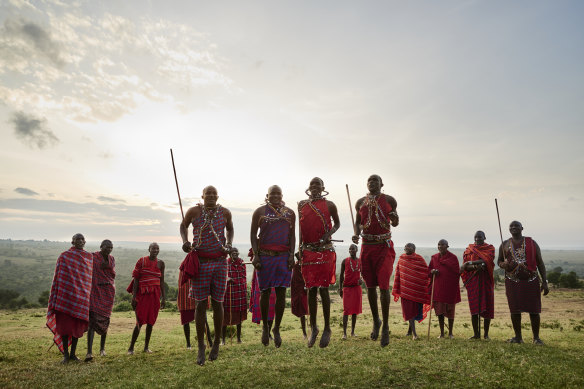
The Maasai visit as part of a cultural exchange.
Nearby, there’s also a school to which Abercrombie & Kent, as part of its philanthropic ventures, has donated a system to provide clean drinking water.
It’s heartwarming to visit the students, chat with them during a break in their studies, talk to the teachers about their expansion plans, and help serve rice and beans for lunch.
At Ol Peteja, I join the K9 anti-poaching dog unit to take part in a series of exercises testing the veteran canine members of the team and the new pups, who can sniff out ammunition in the pockets of poachers from vast distances. Tellingly, that conservancy hasn’t had any poachers for seven and a half years.
Here, you can also see the last two northern white rhinos and visit, at a close distance, an old black rhino who’s lost his sight but is being cared for until his last days.
The circle of life indeed.
Five rules for a successful safari
- Don’t put your arms or legs out of the viewing truck. Wildlife sees the truck as a large animal, but if you “break the line” suddenly, they can become confused and aggressive.
- Take time to look at and admire life in the wild. You’ll always have plenty of time for photos, but it’s a shame to see them only through a lens.
- If you’re taking too many selfies, you’re photographing the wrong animal.
- Never feed the animals, get too close to them or leave any litter behind. They live in a pristine environment that only humans are likely to ruin.
- If you are going to burst into Circle of Life every time you spot an animal do so sotto voce. You risk scaring the wildlife as well as your fellow safari guests.
THE DETAILS
TOUR
An 11-day Wildlife & Warriors safari tour, including Ol Peteja and the Masai Mara, from $24,880 a person, including stays at Kenya’s Sanctuary Tambarare, Ol Pejeta and Sanctuary Olonana, Masai Mara. The price is inclusive of all travel, including flights; vehicle and walking safaris; guided tours; activities like going out with the anti-poaching unit and dogs; luxury accommodation; all meals; drinks; bush picnics; sunset drinks on safari; snacks; and laundry, so you don’t have to take too many clothes. See abercrombiekent.com.au
HEALTH
The World Health Organisation recommends Mpox (monkeypox) vaccines for travellers heading to areas, including Kenya, which are experiencing spikes in the new Mpox variant. Check for other vaccinations, such as for yellow fever that may be required. See traveldoctor.com.au
FLY
Emirates flies three times daily from Sydney and Melbourne to Dubai and twice a day from Dubai to Nairobi. See emirates.com;
VISA
Australians now have access to an electronic visa system for Kenya. The Electronic Travel Authorisation (eTA) can be bought online for $US74 ($109). It takes roughly one week to process and is valid for 90 days. See etakenya.go.ke